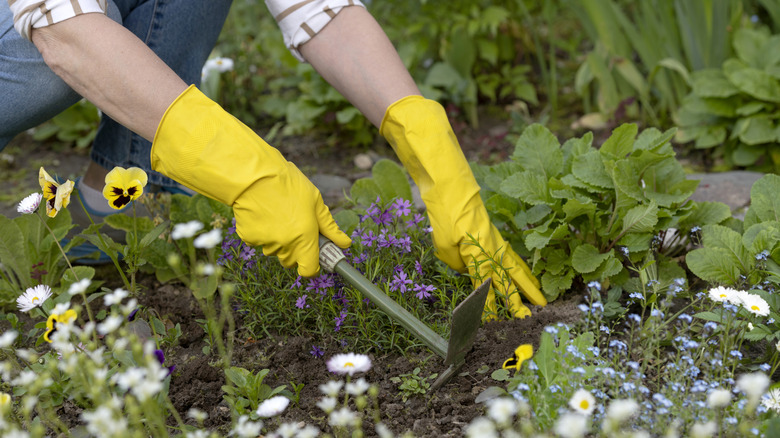We may receive a commission on purchases made from links.
Spurge weed is a low-growing weed that likes to grow in difficult and even inhospitable places, like sidewalk cracks, and also springs up on lawns and flower beds. It’s a nuisance, even though it doesn’t get very big and stays flat against the ground. There are a few different ways to get rid of spurge weed, including “weed and feed” or spray herbicides. But if you’re a gardener who prefers not to use herbicides, there are several non-toxic products that can help eliminate spurge weed from your yard.
Using strong chemical herbicides on weeds is certainly tempting as a way to eradicate them, but there are two things to know: first, herbicides can kill or harm useful pollinators in the garden, such as bees, butterflies, and birds. Second, most herbicides often don’t eradicate weeds fully, as they tend to kill only the green growth and not the root. Since spurge weed has a rather stubborn root system that needs to be fully removed, herbicides are not an effective way to get rid of it.
However, some organic and non-toxic products on the market can be effective in your fight against this stubborn weed. It’s important to use them properly, with the right timing and methods to ensure this weed won’t come back. It may need to be done each season, but with some diligent effort and effective products, you can tackle this pesky weed.
Removal methods for spurge weed

Spurge weed (Euphorbia maculata), also known as spotted spurge weed, or milk-purslane, is very common. It is also drought-tolerant, so it’s one of those weeds that can take hold even in a dry season when other weeds, thirsty for more rain, can’t compete. It reseeds easily and the tiny seeds can lodge themselves almost anywhere. Removing it before it flowers can help reduce the number of seeds that will spread.
Spurge weed likes full sun and warm weather — it won’t survive hard frost. To remove spurge by hand, you have to pull out the entire tap root, which can be difficult, as the root breaks easily. A piece of broken root left in your lawn or a sidewalk crack can sprout a whole new plant, making this weed very frustrating to deal with. To avoid breaking the root, it’s recommended to wait until after there’s been some rain to soften the ground and plump up the root slightly to make it easier to remove.
Pull gently but firmly on spurge weed roots lodged in cracks. After pulling out the root, you can (carefully) pour boiling water into the cracks, which should kill any remaining root segments. In the lawn or flower beds, use a hand tool (such as a steel weed cutter, also useful for removing dandelions) to dig out the entire root.
Best non-toxic products for removing spurge weed
Ecowiser created a list of their top ten recommendations for non-toxic herbicides. Sunday Weed Warrior is a natural product made with insecticidal soap that works well on stubborn weeds. However, it is non-selective, meaning it may kill growth in its path. This is the best choice for spurge weed in sidewalk cracks or similar places away from your lawn or flower beds.
Straight vinegar, or the more concentrated horticultural vinegar, is worth trying, especially on any remaining roots growing in sidewalks or foundations after the top has been pulled out. Use this during dry weather so rain won’t dilute it. There are also some vinegar-based weed killers you can try, which are much less toxic than chemical herbicides. The Green Gobbler brand is organic and made with 20% vinegar to help tackle stubborn weeds. Eco-Garden Pro Organic Vinegar Weed Killer & Grass Killer is an undiluted, fast-working product. It’s safe for groundwater and pets, but is non-selective and needs to be used carefully in lawns. The container does not come with a sprayer.
Espoma Organic Weed Preventer is a great product for the dual purpose of keeping your lawn healthy and deterring weeds. This corn-based product nourishes your lawn all season, and is safe for use around kids and pets. It stops weeds by helping lawns grow thicker and preventing weed seed germination.